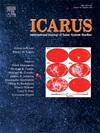Methanol on red TNOs: A link between early composition and irradiation history
IF 2.5
2区 物理与天体物理
Q2 ASTRONOMY & ASTROPHYSICS
引用次数: 0
Abstract
Solid methanol is detected on small icy bodies of the outer solar system, namely trans-Neptunian objects (TNOs). Interestingly, all objects with methanol detections also display a strong positive spectral slope in the visible to near-infrared range, commonly attributed to complex organics, that could be formed by space weathering of methanol ice. We question the relationship between this red color and methanol content by performing irradiation experiments on methanol ices, pure and mixed with water, to simulate the ion bombardment of TNO surfaces. To compare the experimental spectral evolution under irradiation to observations, we focused our investigations on the normalized reflectivity gradient between the J and R photometric bands (JR slope) and the methanol to water abundance ratio post-irradiation. We show that ion irradiation triggers the destruction of methanol and the spectral reddening of the ices. Moreover, we find that JR slopes depend on both irradiation dose and initial ice composition. To account for red slopes alongside detectable methanol ice, we conclude that an irradiation gradient needs to be present at the surface of methanol-rich objects. However, methanol needs to be at least as abundant as water in the initial icy mixture, which suggests an early segregation of the icy species. We provide an estimation of the irradiation doses received at different depths of methanol-rich TNO surfaces, consistent with surface exposures of 4.5 Gyrs.
甲醇在红色TNOs上:早期组成与辐照史之间的联系
固体甲醇是在太阳系外的小冰体,即海王星外天体(TNOs)上检测到的。有趣的是,所有检测到甲醇的物体在可见光到近红外范围内也显示出强烈的正光谱斜率,通常归因于复杂的有机物,可能是由甲醇冰的空间风化形成的。我们通过对纯甲醇冰和与水混合的甲醇冰进行辐照实验来模拟TNO表面的离子轰击,从而质疑这种红色与甲醇含量之间的关系。为了比较辐照下的实验光谱演变与观测结果,我们重点研究了J和R光度带之间的归一化反射率梯度(JR斜率)和辐照后的甲醇水丰度比。我们表明离子辐照触发甲醇的破坏和冰的光谱变红。此外,我们发现JR斜率与辐照剂量和初始冰成分有关。为了解释红色斜坡和可探测的甲醇冰,我们得出结论,在富含甲醇的物体表面需要存在辐射梯度。然而,在最初的冰混合物中,甲醇至少需要和水一样丰富,这表明冰种的早期分离。我们提供了在富含甲醇的TNO表面不同深度处接受的辐照剂量的估计,与表面暴露的~ 4.5 Gyrs一致。
本文章由计算机程序翻译,如有差异,请以英文原文为准。
求助全文
约1分钟内获得全文
求助全文
来源期刊

Icarus
地学天文-天文与天体物理
CiteScore
6.30
自引率
18.80%
发文量
356
审稿时长
2-4 weeks
期刊介绍:
Icarus is devoted to the publication of original contributions in the field of Solar System studies. Manuscripts reporting the results of new research - observational, experimental, or theoretical - concerning the astronomy, geology, meteorology, physics, chemistry, biology, and other scientific aspects of our Solar System or extrasolar systems are welcome. The journal generally does not publish papers devoted exclusively to the Sun, the Earth, celestial mechanics, meteoritics, or astrophysics. Icarus does not publish papers that provide "improved" versions of Bode''s law, or other numerical relations, without a sound physical basis. Icarus does not publish meeting announcements or general notices. Reviews, historical papers, and manuscripts describing spacecraft instrumentation may be considered, but only with prior approval of the editor. An entire issue of the journal is occasionally devoted to a single subject, usually arising from a conference on the same topic. The language of publication is English. American or British usage is accepted, but not a mixture of these.
 求助内容:
求助内容: 应助结果提醒方式:
应助结果提醒方式:


